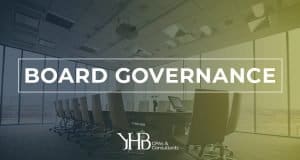 Every organization wants proper board governance, however, most lack clarity on what it truly means. While we encourage every organization to establish a training program for new board members, it’s important to make sure even long serving members are current on relevant matters. Board governance is defined as “the set of responsibilities and practices exercised by the board and executive management with the goal of providing strategic direction, ensuring that objectives are achieved, ascertaining that risks are managed appropriately and verifying that the organization’s resources are used responsibly.”
Every organization wants proper board governance, however, most lack clarity on what it truly means. While we encourage every organization to establish a training program for new board members, it’s important to make sure even long serving members are current on relevant matters. Board governance is defined as “the set of responsibilities and practices exercised by the board and executive management with the goal of providing strategic direction, ensuring that objectives are achieved, ascertaining that risks are managed appropriately and verifying that the organization’s resources are used responsibly.”
Board Responsibilities
Let’s break down the definition and start with responsibilities. The board’s responsibilities can be summarized in three duties – duty of care, duty of loyalty, and duty of obedience. The duty of care instructs the board to conduct the affairs of the organization in the way a prudent person would. The duty of loyalty instructs the board to be loyal in its dealings and put the organization’s needs above your own. The duty of obedience instructs the board that it should be faithful to the mission and actions should support the mission.
Typical Not-for-Profit Committees
Strategic direction can be achieved through the work at committee level and is often key to keeping board members and volunteers engaged in the mission of the organization. The more common committees include executive, finance, audit, development, investment, compensation, and risk management. The executive committee acts on behalf of the board when it is not necessary or possible to have a meeting of the full board. The finance committee oversees the budget and monitors cash flow. The audit committee monitors internal controls, compliance with laws, and communicates with the auditors. The development committee encourages fund raising. The investment committee oversees investment policy and investment returns. The compensation committee oversees the compensation of executives and other highly compensated individuals by comparing compensation to other organizations and documenting the results. The risk management committee oversees the risk assessment process.
Depending on the size of the organization, risk management committee responsibilities are often rolled into other groups. Nonetheless, the mission of this committee is critical for the long-term success of any organization. Risks can be managed by using what is known as the risk management approach. This approach can be divided into four phases:
- Identify the possibilities of risk to the organization.
- Understand the likelihood that this risk could occur and the magnitude of the ramifications to the organization if it did occur.
- Plan for a response before, not after, the fact.
- Put mechanisms in place to mitigate the risk.
Using Resources Responsibly
The last part of the governance definition is using resources responsibly and can be achieved through financial information. Auditors present the audited financial statements to the board or the audit committee annually, but internal financials should be provided more frequently. The board has a fiduciary responsibility to read and analyze the financial statements; a financial expert may serve on the board to oversee this responsibility. Internal controls over financial reporting are also an important part of a strong organization. The Form 990 is a useful tool to combine financial information with governance disclosures for the board and other readers in the public. (Stay tuned for article two to see how governance is relevant in the Form 990.)While not always the most exciting part of running a not-for-profit, proper board governance is key to making sure your organization is able to accomplish its mission.
READY TO TALK TO AN EXPERT? CONTACT OUR NOT-FOR-PROFIT & GOVERNMENTAL SERVICES TEAM.
About the Author
 Olivia graduated with a Bachelor’s degree in Accounting in May 1998 from Bridgewater College. She joined the firm in June 1998. During her time with the firm, her focus has been on private schools, religious organizations, associations, colleges, foundations, private foundations museums, and other nonprofit entities. She holds two Not-for-Profit certificates – one in Nonprofit Management sponsored by UVA and one through the AICPA.
Olivia graduated with a Bachelor’s degree in Accounting in May 1998 from Bridgewater College. She joined the firm in June 1998. During her time with the firm, her focus has been on private schools, religious organizations, associations, colleges, foundations, private foundations museums, and other nonprofit entities. She holds two Not-for-Profit certificates – one in Nonprofit Management sponsored by UVA and one through the AICPA.

